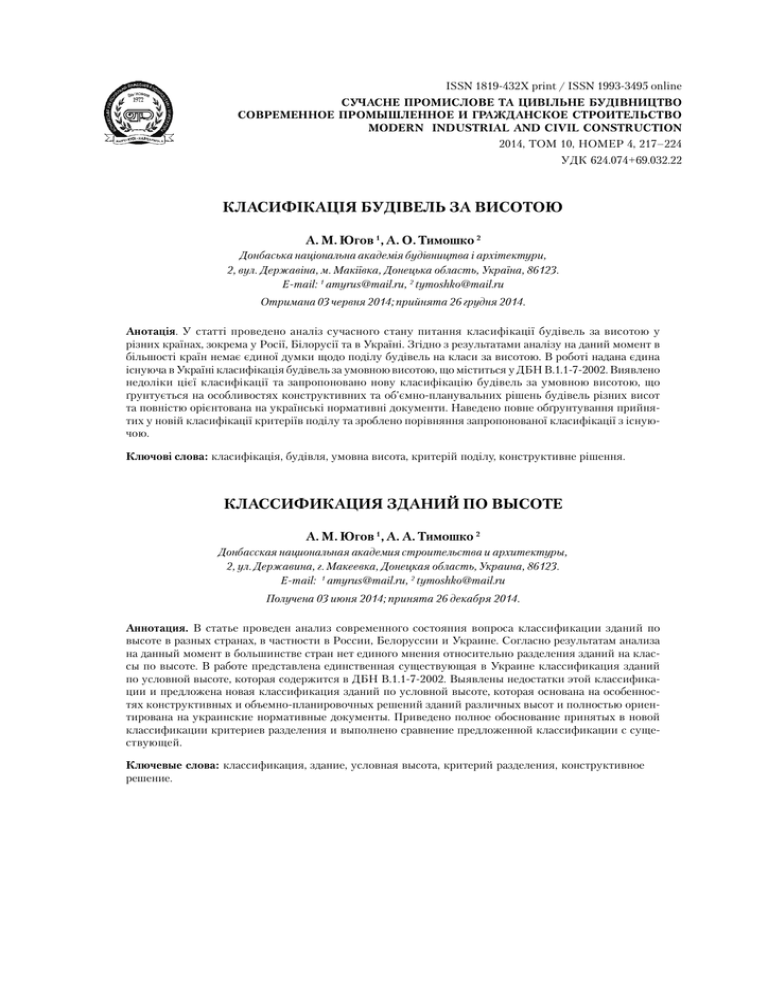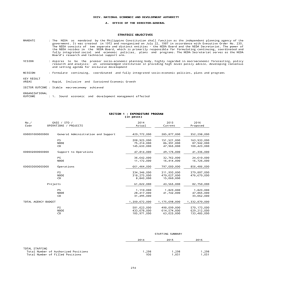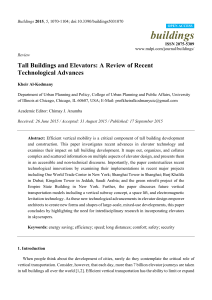Классификация зданий по высоте
advertisement

ISSN 1819432X print / ISSN 19933495 online СУЧАСНЕ ПРОМИСЛОВЕ ТА ЦИВІЛЬНЕ БУДІВНИЦТВО СОВРЕМЕННОЕ ПРОМЫШЛЕННОЕ И ГРАЖДАНСКОЕ СТРОИТЕЛЬСТВО MODERN INDUSTRIAL AND CIVIL CONSTRUCTION 2014, ТОМ 10, НОМЕР 4, 217–224 УДК 624.074+69.032.22 КЛАСИФІКАЦІЯ БУДІВЕЛЬ ЗА ВИСОТОЮ А. М. Югов 1, А. О. Тимошко 2 Донбаська національна академія будівництва і архітектури, 2, вул. Державіна, м. Макіївка, Донецька область, Україна, 86123. Еmail: 1 amyrus@mail.ru, 2 tymoshko@mail.ru Отримана 03 червня 2014; прийнята 26 грудня 2014. Анотація. У статті проведено аналіз сучасного стану питання класифікації будівель за висотою у різних країнах, зокрема у Росії, Білорусії та в Україні. Згідно з результатами аналізу на даний момент в більшості країн немає єдиної думки щодо поділу будівель на класи за висотою. В роботі надана єдина існуюча в Україні класифікація будівель за умовною висотою, що міститься у ДБН В.1.172002. Виявлено недоліки цієї класифікації та запропоновано нову класифікацію будівель за умовною висотою, що ґрунтується на особливостях конструктивних та об'ємнопланувальних рішень будівель різних висот та повністю орієнтована на українські нормативні документи. Наведено повне обґрунтування прийня тих у новій класифікації критеріїв поділу та зроблено порівняння запропонованої класифікації з існую чою. Ключові слова: класифікація, будівля, умовна висота, критерій поділу, конструктивне рішення. КЛАССИФИКАЦИЯ ЗДАНИЙ ПО ВЫСОТЕ А. М. Югов 1, А. А. Тимошко 2 Донбасская национальная академия строительства и архитектуры, 2, ул. Державина, г. Макеевка, Донецкая область, Украина, 86123. Еmail: 1 amyrus@mail.ru, 2 tymoshko@mail.ru Получена 03 июня 2014; принята 26 декабря 2014. Аннотация. В статье проведен анализ современного состояния вопроса классификации зданий по высоте в разных странах, в частности в России, Белоруссии и Украине. Согласно результатам анализа на данный момент в большинстве стран нет единого мнения относительно разделения зданий на клас сы по высоте. В работе представлена единственная существующая в Украине классификация зданий по условной высоте, которая содержится в ДБН В.1.172002. Выявлены недостатки этой классифика ции и предложена новая классификация зданий по условной высоте, которая основана на особеннос тях конструктивных и объемнопланировочных решений зданий различных высот и полностью ориен тирована на украинские нормативные документы. Приведено полное обоснование принятых в новой классификации критериев разделения и выполнено сравнение предложенной классификации с суще ствующей. Ключевые слова: классификация, здание, условная высота, критерий разделения, конструктивное решение. 218 Anatoliy Yugov, Andrii Tymoshko CLASSIFICATION OF BUILDINGS ON HEIGHT Anatoliy Yugov 1, Andrii Tymoshko 2 Donbas National Academy of Civil Engineering and Architecture, 2, Derzhavina Str., Makiyivka, Donetsk Region, Ukraine, 86123. Еmail: 1 amyrus@mail.ru, 2 tymoshko@mail.ru Received 03 June 2014; accepted 26 December 2014. Abstract. The article analyzes the current state of the question of classification of buildings on height in different countries, particularly in Russia, Belarus and Ukraine. According to the results of this analysis, at this moment in most countries there is no consensus about the division of buildings into classes according to their height. The only existing in Ukraine classification of buildings by conditional height, which is contained in DBN V.1.172002, is presented in this paper. Disadvantages of this classification have been identified and new classification of buildings by conditional height, which is based on the features of structural and spaceplanning solutions of buildings with different heights and fully oriented on the Ukrainian normative documents, is proposed. Complete substantiation of adopted in the new classification criteria of division and comparison of proposed classification with the existing have been represented in this paper also. Keywords: classification, building, conditional height, criterion of division, structural solution. Formulation of the problem Construction is the sphere of industry developing the most dynamically. The design methods, struc tural systems of buildings, erection of buildings pro cesses and building material used for production of building structure have been permanently improved. Thus, the height of buildings and structures is in creased in due course reaching new and new sym bols. Once upon a time, when houses were used to be singlestorey, there was no their classification prob lem by the height. But with the technical progress development and appearance of multistorey build ings, the problem of division of buildings into the various groups came into being. The first versions of classification of the buildings on the height were relatively simple (e.g. singlestorey and highrise ones) because there were not buildings with differ ent singularities. But, as was pointed out, the con struction is in progress and in due course highrise buildings became different on their space and plan ning conceptions in accordance with applied tech nical and structural methods used in them, in this connection the height of the given buildings as be forehand was increased rapidly. The initial smelting of pig iron by Abraham Derby in 1720, discovery of a lift in 1864, introduction into action of openhe arth furnace and beginning of steel application in construction in 1864 promoted for development of highrising construction that, in its turn, compli cated the problem of classification of the buildings by the height. Besides, as E. N. Kodish [1] pointed out, at the end of XIX century the USA constructed new category of buildings – multistorey construc tion, that is for the first time the term «highrising building» was used. This is confirmed by the fact that still in 1883 an architect William la Baron Genny constructed 10storey building «Home Insurance Building» with height of 55 meters in Chicago was assumed as the first highrising building. The ap pearance of new types of buildings and their devel opment demanded not only the improvement of old ones but creation of new more complicated classifi cations on the height. That is, generalizing the above mentioned infor mation, one can confirm that it is necessary to clas sify buildings by the height which is connected with the variety highrising buildings from the point of view of spaceplanning and structural peculiarities that preclude the possibilities to refer all the high rising buildings to some kind of a class. Nowadays in Ukraine the problems of classifica tion of buildings on the height are rather complicat ed ones. In spite of the rapid development of con structional sphere and appearance in Ukrainian meg alopolises higher buildings, the analysis of the prin cipal normative documents regulating design of dif ferent types of buildings: NCR V.1.172002 [2], Classification of buildings on height NCR V 2.2242009 [3], NCR V.2.2152005 [4] revealed that at the present moment there is the only classification of buildings by height, exactly by con ditional height which is in the NCR V.1.172002 [2]. The more indepth analysis of the document dis covered that this classification was made merely on the basis of various types of evacuation methods in buildings but civil engineers need classification di viding building on the height on the basis of pecu liarities of structural and space and planning con ceptions of the buildings but there is no such kind of classification at all in Ukraine. The purpose of the paper The study of the problem of buildings classification on the height in different countries and producing of buildings classification on the height depending on structural singularities of buildings of various height in accordance with regulations of the Ukrai nian Construction Rules. The analysis of existing classifications The analysis of the papers by L. A. Viktorova [5], Yu. G. Granik [6], A. Tarantsev [7], V. Kravtsov [8], Yu. I. Potapova [9], I. S. Yermolovich and N. M. Va silets [10] and also A. M. Asaul and S. M. Ivanov [11] revealed that in spite of the rich world practice of construction of highrising buildings there is no uniform classification of buildings on the height yet. Besides there are two types of parallel measurement of highrising buildings – in meters and in storeys or floors. In her paper L. A. Viktorova [5] connects it with peculiarities of different normative docu ments in dependence on the tasks to solve which are directed the contents one or another document. In this connection, A. Tarantsev, Yu. Potapova and I. Yermolovich in their papers [7, 9, 10] reached the common conclusion that application of the criteri on of the height in meters is more correct because the height of storeys in a building can be distin guished from the building purpose and demands of the National Designing Rules. As was pointed out earlier, nowadays there is no a unified idea how to classify buildings on the height because all the existing classifications are rather conditional and distinct from each other. The first attempt to divide buildings by the given indication was done at the symposium of CMEA in Moscow in 219 1976. At that time, the common classification of buildings on the height in meters was accepted. In the classification, the buildings higher than 30m were fallen in the category of the highrise build ings, the buildings up to 50, 75 and 100 meters, re spectively, to I, II and III category of highrising buildings and the buildings higher 100 meters (that is approximately with 30 storeys) to skyscrapers. The fact was represented in the papers of V. Kravt sov [8], A. Tarantsev [7], I. Yermolovich [10] and in the coursebook by V. Shuller [12]. It can be said that the given classification has been still used in Russia in application to public buildings. But the frameworks accepted by CMEA are not rigid, so in many countries the concepts «multistorey», «highrising» and «highrise build ing» are distinguished depending on designing tra ditions adopted in one or another country. Concerning the contemporary classification of buildings on the height in Russia, it is rather com plicated problem because of the fact that various sources of information give different explanation of the similar terms and as a consequence, different clas sification of buildings. For instance, A. M. Asaul in his paper [11] refers buildings with height up to 3 storeys to lowrise ones, with height of 4–9 storeys to highrise buildings, with height of 10–20 storeys to multistorey buildings and buildings higher than 20 storeys as skyscrapers. A. Tarantsev [7] gives the similar classification but he refers to lowrise buildings that are higher than 1–2 storeys and to highrise buildings that are higher than 16 storeys. It should be pointed out that in spite of all disad vantages of the classification of buildings on the number of storeys, residential buildings in Russia are accepted to be classified namely by this criteri on. Total analysis of classification of buildings in Russia was also made in the papers of I. Yermolovich and N. Vasilets [10]. They state that starting from the fireprotection requirements and requirements of normative documents, such as MESR 4.192005 «Temporary rules of designing of mutifunctional highrise buildings and complex buildings in Mos cow» [13] and TCR 313322006 «Residential and public highrising buildings» [14] the practice of reference to highrising buildings higher than 75 meters (approximately 25 storeys) became custom ary in Russia. On the basis of the statement, they offer the following classification of the buildings on 220 the height: lowrise buildings – 1–2 storeys, aver agerise buildings – 3–5 storeys, multistorey build ings – 6–10 storeys, highrise buildings – 11–25 storeys, skyscrapers – more than 25 storeys. L. A. Viktorova, V. Kravtsov and Yu. Potapova hold the same point of view to refer buildings to one or another group in their papers [5, 8, 9]. It should be notice that in accordance with [15], multistorey buildings relate to the structures more than 10–25 storeys on the territory of Russian Federation and this piece of information practically coincides with abovementioned classification by I. Yermolovich and N. Valilets. In other countries, e. g. in Belorussia, there is another classification of the buildings on the height. Belorussian rules TCR 453.021082008 «High rise buildings. Construction rules of designing» [16] has been established that to highrise buildings are related multistorey buildings with height from 75 to 100 meters and public buildings and buildings of multifunctional assignment with height from 50 to 200 meters. In connection with it, in accordance to point 3.1 of the document, the height of the build ing is the difference of marks from the surface of roadway of the nearest passageway to the building up to level mark of the upper storey floor not con sidering maintenance storey. By the way, the similar designation is given in the Ukrainian NCR V.1.17 2002 [2] as «a conditional building height». A. Kravtsov [8] connects height restriction in a residential zone with the fact that 100 m is a low mark above the cities and towns in a country of cloud iness and smog which can bring to the health wors ening of people living on the upper floors, that is to progress such diseases like «seasickness» or high at titude sickness. Besides, the standards of the Re public of Belorussia RTC P 23312013 «Classifica tion of buildings and structures» [17] relate build ings higher than 30 m. In the paper of L. A. Viktorova [5], there is the example of classification of buildings on the height in Germany. According to the classification, all the buildings are divided into 4 groups: I. are the build ings with height 22–30 m, II. with height 30–60 m, III. with height over 60 m and IV. with height over 200 m. From this point, one can make a conclusion that there are different concepts concerning high rising of the buildings in various countries thus, clas sification of various countries differ between each other countries. Anatoliy Yugov, Andrii Tymoshko Concerning classification of buildings on the height in Ukraine, as it has been pointed out al ready, the analysis of the normative documents NCR V.1.172002 [2], NCR V.2.2242009 [3], NCR V.2.2152005 [4] showed that the uniform acting at the present moment classification have been just given in NCR V.1.172002 «Fire safety of building objects» [2]. But to the base of classification was laid just criteria of fire safety connected with differ ent ways of evacuation of people from the buildings. Nevertheless, as L. A. Viktorova points out correct ly, highrising of a building depends on largely on its space and planning, structural and other singu larities that determined by requirements to resis tance and reliability of the structural system of a building. Thus, we are mostly interested by the clas sification of buildings on the height just from the point of view of structural criteria of division. But, unfortunately, there is no such kind of classification in Ukraine. NCR V.1.172002 «Fire safety of building ob jects» [2] classifies all buildings by the conditional height in the following way: а) lowrise buildings – height is Н ≤9 m (as a rule up to 3 storeys including); b) multistorey buildings – height is 9 m < H ≤ 26.5 m (as a rule up to 9 storeys including); c) highrise buildings – height is 26.5 < H ≤ 47 m (as a rule up to 16 storeys); d) skyscrapers – height is 47 m (as a rule more than 16 storeys). In this connection, for conditional height NCR V.1.172002 [2] takes the height of arrangement of the upper floor without regard to the upper storey for utility services. In turn, the height of arrange ment of the upper floor is determined by distinction of marks of the passageway surface for fire engines and floor of the upper storey. However, more indepth analysis of the given classification showed that it is composed on the ba sis of criteria of fire safety of buildings. For instance, point 5.36 of NCR V.1.172002 [2] determines that in buildings with conditional height of not more than 9 m (lowrise buildings) it is permitted to stip ulate staircases of the type SC2 (Staircase 2), the same point points out that in buildings with the con ditional height of not more than 26.5 m (multisto rey buildings) the staircase of the type SC1 (Stair case 1) is used. The point 5.39 of NCR V.1.172002 [2] states that in buildings with conditional height Classification of buildings on height 221 of more than 26.5 m (highrise buildings) pressur ized staircases are stipulated. And, at last, point NCR V.1.172002 [2] states that in the building with conditional height of more than 47 m (skyscrapers) there should be stipulated lifts or elevators to trans port a subdivision of the fire guard. Summing up the abovementioned information, one can make the conclusion that given in NCR V.1.172002 [2] clas sification of the buildings on the height is composed completely on the basis from different ways of evacu ation for building of various height. Classification of buildings on height and number of storeys As it was pointed out earlier, we are mostly inter ested by classification of buildings on the height which would be based on structural singularities of buildings with various height. Thus, according to the purpose of investigation, the classification of buildings on the conditional height was composed that based on just structural criteria of division which are standardized by regulations NCR V.1.1 72002 [2], NCR V.2.2242009 [3] and NCR V.2.2 152005 [4]. It has the following mode: а) lowrise buildings – height is H ≤ 12 m ( as a rule up to 4 storeys including); b) multistorey buildings – height is 12 m < H ≤ 26.5 m (as a rule up to 9 storeys in cluding); c) highrise buildings – height is 26.5 < H ≤ 73.5 m (as a rule up to 25 storeys); d) skyscrapers – height is H > 73.5 m (as a rule more than 25 storeys). The complicated «structural» classification can be also given in the form of comparison with existing «fire hazard classification» (see Figure). Note: since the regulation of ruling documents on the territory of Ukraine NCR V.1.172002 [2], NCR V.2.2242009 [3], NCR V.2.2152005 [4] is oriented to the conditional height of the buildings (see point 2.18 [2]) so the proposed «structural» classification is also composed in dependence on the conditional height of the buildings. At pointing out of approximate height of buildings of various groups, the average height of the floor of 3 m was used. In contrast to «fire» classification NCR V.1.1 72002, in «structural» classification in the limits between various groups of buildings there are ele ments that impact to the principal choice of struc tural or space and planning solution of a building in Figure. Comparison of the proposed «structural» classification of buildings on the height (on the left) and classification of the buildings on NCR V.1.172002 (on the right). the whole. The instance for a limit between lowrise (<12 m) and multistorey buildings (>12 m) a lift was accepted, that the buildings without lifts are proposed to relate to lowrise ones. The equipment the buildings with lifts is regulated by the point 5 of NCR V.2.2152005 [4], just the point 5.1 states that in buildings higher of 5 and more (that is > 12 m) the lift is installed necessarily. The lift was taken for the limit of classification because the appearance of lift shaft in a building changes its space and plan ning solution significantly in comparison with build ings without a lift. It should be pointed out that NCR V.2.2152005 [4] represents a term «lowrise building» as construction of the territory with one, two or three storey buildings (<9 m) but in this case it is not completely clear why three storeys are the limit. For the limit between multistorey buildings (<26.5 m) and highrise buildings (>26.5 m), as in the «fire» classification [2] pressurized staircases were accepted because their appearance also effect to the choice of the space and planning and structural solution because that to such kind of staircases spe cial requirements introduce concerning their arrange ment in a building. In the contrast to classification 222 Anatoliy Yugov, Andrii Tymoshko on [2], in the proposed «structural» classification pressurized staircases are considered to be as a struc tural element but not as the way of evacuation. Ap plication of pressurized staircases in the buildings is regulated by point 5.39 of NCR V.1.172002 [2], which establish that pressurized staircases should be stipulated in the buildings with conditional height more than 26.5 m. At last, for the limit between highrise buildings and skyscrapers were accepted the mark of 73.5 m. For the first time in Ukraine the designing of build ings higher than 73.5 m is regulated by the separate document NCR V.2.2242009 «Design of residen tial and civil skyscrapers» [3] which gives the term «a skyscraper» as «a multistorey building of resi dential and civil application with conditional height from 73.5 m and higher». Secondly, the buildings higher than 73.5 m require quite another approach es to design in the whole since there are no increased requirements to highrising buildings concerning resistance and reliability of structural system. The fact is also represented in papers of V. Kravtsov [8] and I. Yermolovich [10]. Besides, Yu. Granik in his paper [6] correctly notes that with increasing of the height of a building the load to loadbearing struc tures is increased sharply (mainly the dead load and wind load). In connection with it, L. Viktorova in her paper [5] points out that in buildings higher than 75m principally another types of structural sys tems are applied (e.g. shaft or box systems) that dis tinguish them from the buildings of less height. References References 1. Кодыш, Э. Н. Проектирование многоэтажных зда ний с железобетонным каркасом [Text] : [моно графия] / Э. Н. Кодыш, Н. Н. Трекин, И. К. Ники тин. – М. : Издательство Ассоциации строитель ных вузов, 2009. – 352 с. – ISBN 9785930936797. 2. ДБН В.1.172002. Пожежна безпека об'єктів буд івництва [Text]. – На заміну СНиП 2.01.0285* ; введ. 01.05.2003. – К. : Держбуд України, 2003. – 42 с. – (Державні будівельні норми України). 3. ДБН В.2.224:2009. Проектування висотних жит лових і громадських будинків [Text]. – Введено вперше ; чинні від 2009–09–01. – К. : Мінрегіон буд України, 2009. – 133 с. – (Державні будівельні норми України). 4. ДБН В.2.2152005. Житлові будинки. Основні положення [Text]. – На заміну СНиП 2.08.0189, ДБН 7992 ; чинні від 2006–01–01. – К. : Держбуд 1. Kodysh, E. N.; Trekin, N. N.; Nikitin, I. K. Designing of multistory buildings, having reinforced concrete frame. Monograph. Moscow: Publishing house of Association of Construction Institutes, 2009. 352 p. ISBN 9785930936797. (in Russian) 2. DBN V.1.172002. Fire safety of civil engineering objects. Kyiv: State Committee for Construction of Ukraine, 2003. 42 p. (in Ukrainian) 3. DBN V.2.224:2009. Designing of highrise apartment and civil buildings. Kyiv: Ministry of Regional Development of Ukraine, 2009. 133 p. (in Ukrainian) 4. DBN V.2.2152005. Apartment buildings. Funda mental. Kyiv: State Committee for Construction of Ukraine, 2005. 36 p. (in Ukrainian) 5. Viktorova, L. A. Highrise buildings – advantages and disadvantages of civil engineering. In: Architecture Conclusion The problem of building classification on the height is especially acute in the world. It arose in the XIX century with appearance of skyscrapers and further more required permanent study and improvement of existent classification. Nowadays, there are many clas sifications of buildings on the height which are dif ferent between each other via various conceptions concerning the height of buildings in different coun tries. With respect to classification of building on the height in Ukraine, the analysis of normative doc uments showed that at the present moment there is only one classification based on foundation of require ments of fire safety of buildings but it is not com pletely proved from point of view to their structural solutions. In the proposed paper of «structural» clas sification of buildings the structural singularities of buildings of various height are accepted for criteria of division of buildings to the groups, namely: pres ence or absence of lifts in pressurized staircases and application of specific structural systems for skyscrap ers. This classification solves the problem of absence engineering classification of buildings on the height in Ukraine and can be applied in construction prac tice to determine a group of any building. 223 Classification of buildings on height 5. 6. 7. 8. 9. 10. 11. 12. 13. України, 2005. – 36 с. – (Державні будівельні нор ми України). Викторова, Л. А. Высотные здания – плюсы и минусы строительства [Еlectronic resource] / Л. А. Викторова // Архитектура и строительство России. – 2012. – № 10. – Режим доступа к ста тье : http://www.asrmag.ru/article/vysotnye zdaniya/. – (Дата обращения 14.03.2014). – На звание с экрана. Граник, Ю. Г. Проектирование и строительство высотных зданий [Еlectronic resource] / Ю. Г. Гра ник // Энергосбережение. – М. : ООО ИИП «АВОКПРЕСС», 2004. – № 2. – С. 92–97. – Ре жим доступа к статье : http://www.abok.ru/ for_spec/articles.php?nid=2444 (Дата обращения 14.03.2014). – Название с экрана. Таранцев, А. Нормативы берут высоту [Еlectronic resource] / Александр Таранцев, Станислав Жа ров, Андрей Куянов // БДИ : Журнал. – 2005. – № 4(61). – С. 30–34. – Режим доступа к статье : http://mx1.algoritm.org/61/61_Gefest.htm (Дата обращения 14.03.2014). – Название с экрана. Кравцов, В. Высотные здания. Особенности про ектирования, строительства и мониторинг фун даментов [Еlectronic resource] / Владимир Крав цов // Архитектура и строительство. – 2010. – № 1(212). – Режим доступа к статье : http:// ais.by/story/5540 (Дата обращения 14.03.2014). – Название с экрана. Потапова, Ю. И. Высотное строительство в Рос сии – проблемы, задачи и способы их решения [Text] / Ю. И. Потапова // Успехи современного естествознания / гл. ред. М. Ю. Ледванов. – 2012. – № 6. – С. 14–16. – ISSN 16817494. Ермолович, И. С. Обзор строительного рынка жилой недвижимости города Красноярска по этажности зданий [Еlectronic resource] / И. С. Ермолович, Н. М. Василец // Молодежь и наука : сборник материалов IX Всероссийской научнотехнической конференции студентов, ас пирантов и молодых ученых с международным участием, посвященной 385летию со для осно вания г. Красноярска / отв. ред. О. А. Краев. – Красноярск : Сибирский федеральный универ ситет, 2013. – Режим доступа к статье : http:// conf.sfukras.ru/sites/mn2013/thesis/s096/s096 002.pdf (Дата обращения: 14.03.2014). – Назва ние с экрана. Асаул, А. Н. Экономика недвижимости [Text] : [учебник для вузов] / А. Н. Асаул, С. Н. Ива нов, М. К. Старовойтов. – 3е изд., исправл. – СПб. : АНО «ИПЭВ», 2009. – 304 с. – ISBN 9785914600188. Шуллер, В. Конструкции высотных зданий [Text] / В. Шуллер ; пер. с англ. Л. Ш. Килимника ; под ред. Г. А. Казиной. – М. : Стройиздат, 1979. – 248 с. МГСН 4.192005. Временные нормы и правила проектирования многофункциональных высот ных зданий и зданийкомплексов в городе Москве [Text]. – Введены впервые ; действуют с момента 6. 7. 8. 9. 10. 11. 12. 13. 14. 15. 16. 17. and Construction of Russia, 2012, № 10. Accessed at: http://www.asrmag.ru/article/vysotnyezdaniya/. (in Russian) Granik, Yu. G. Highrise design and construction. In: Energy saving, 2004, № 2, p. 92–97. Accessed at: http://www.abok.ru/for_spec/articles.php?nid=2444. (in Russian) Tarantsev, Aleksandr; Zharov, Stanislav; Kuianov, Andrei. Standards clear the bar. In: BDI, 2005, № 4(61), p. 30–34. Accessed at: http:// mx1.algoritm.org/61/61_Gefest.htm. (in Russian) Kravtsov, V. Highrise buildings. Particularities of designing, civil engineering and monitoring of foundations. In: Architecture and construction, 2010, № 1(212). Accessed at: http://ais.by/story/5540. (in Russian) Potapova, Yu. I. Highrise construction in Russia – problems, tasks and methods of solutions. In: Adva nce of Modern Natural Sciences / Edited by M. Yu. Led vanov, 2012, № 6, p. 14–16. ISSN 16817494. (in Ru ssian) Ermolovich, I. S.; Vasilets, N. M. Rewiew of construc tional residential property market of Krasnoyarsk according to number of stories in a building. In: Youth and science: source book of IXth AllRussian scientific and technical conference of students, postgraduates, young scientists of international participation devoted to perennity from the date of foundation of Krasnoyarsk / Edited by O. A. Kraev. Krasnoyarsk: Siberian federal university, 2013. Accessed at: http://conf.sfukras.ru/sites/mn2013/ thesis/s096/s096002.pdf. (in Russian) Asaul, A. N.; Ivanov, S. N.; Starovoitov, M. K. Real estate economics. 3rd ed., Corrected. St. Petersburg: ANO «IPEV», 2009. 304 p. ISBN 9785914600188. (in Russian) Shuller, V. Construction of highrise buildings. Mos cow: Stroiizdat, 1979. 248 p. (in Russian) MGSN 4.192005. Temporary regulations and design rules of multifunction highrise buildings and buil dingcomplexes in Moscow. Moscow: GUP «NIAC», 2006. 124 p. (in Russian) TSN 313322006. Residential and social highrise buildings. St. Petersburg: Government of St. Pe tersburg, 2006. 59 p. ISBN 5878971291. (in Russian) Povzik, Ya. S. Reference book of Manager of Fire Fighting Operations. Moscow: ZAO «SPETS TEHNIKA», 2004. 361 p. ISBN 5901018400. (in Russian) TKP 453.021082008. Highrise buildings. Construction standards of designing. Minsk: The Ministry of Architecture and Construction of Re public of Belarus, 2008. 94 p. (in Russian) STB P 23312013. Classification of buildings and constructions. Fundamental principles. Minsk: Gosstandart, 2013. 5 p. (in Russian) 224 14. 15. 16. 17. Anatoliy Yugov, Andrii Tymoshko опубликования. – М. : ГУП «НИАЦ », 2006. – 124 с. – (Московские городские строительные нормы). ТСН 313322006. Жилые и общественные высот ные здания [Text]. – Взамен ТСН 213042003 ; дата введения 28.04.2006. – СПб. : Правительство Санкт Петербурга, 2006. – 59 с. – ISBN 5878971291. – (Территориальные строительные нормы). Повзик, Я. С. Справочник руководителя туше ния пожара [Текст] / Я. С. Повзик. – М. : ЗАО «СПЕЦТЕХНИКА», 2004. – 361 с. – ISBN 5901018400. ТКП 453.021082008. Высотные здания. Строи тельные нормы проектирования [Text]. – Дата введения 2008–12–01. – Минск : Министерство архитектуры и строительства Республики Бела русь, 2008. – 94 с. СТБ П 23312013. Классификация зданий и со оружений. Основные положения [Text]. – Дата введения 2013–12–01 ; дата окончания действия 2015–12–01. – Минск : Госстандарт, 2013. – 5 с. – (Предварительный государственный стандарт Республики Беларусь). Югов Анатолій Михайлович – д. т. н., професор, завідувач кафедри технології і організації будівництва Дон баської національної академії будівництва і архітектури. Член Української асоціації з металевих конструкцій, член Міжнародної асоціації просторових конструкцій, член Української спілки з неруйнівного контролю та технічної діагностики. Наукові інтереси: експлуатаційна надійність будівельних металевих конструкцій, техні чна діагностика будівельних конструкцій, технологія і організація монтажу металевих конструкцій, робота металевих конструкцій з урахуванням монтажних станів. Тимошко Андрій Олександрович – аспірант кафедри технології і організації будівництва Донбаської націо нальної академії будівництва і архітектури. Наукові інтереси: напруженодеформований стан висотних буді вель з металевих конструкцій з урахуванням монтажних впливів. Югов Анатолий Михайлович – д. т. н., профессор, заведующий кафедрой технологии и организации строи тельства Донбасской национальной академии строительства и архитектуры. Член Украинской ассоциации по металлическим конструкциям, член Международной ассоциации по пространственным конструкциям, член Украинского общества по неразрушающему контролю и технической диагностике. Научные интересы: эксплу атационная надежность строительных металлических конструкций, техническая диагностика строительных конструкций, технология и организация монтажа металлических конструкций, работа металлических конст рукций с учетом монтажных состояний. Тимошко Андрей Александрович – аспирант кафедры технологии и организации строительства Донбасской национальной академии строительства и архитектуры. Научные интересы: напряженнодеформированное со стояние высотных зданий из металлических конструкций с учетом монтажных воздействий. Yugov Anatoliy – DSc (Eng.), Professor; Principal of Construction Technology and Management Department, Donbas National Academy of Civil Engineering and Architecture. He is a Member of Ukrainian Association of Metal Construction, Member of the International association of spatial construction, Member of the Ukrainian society under the undestroyed control and technical diagnostics. His research interests include: the reliability of existing metal structures, technical diagnostics of building designs, technology and management of metal structures erec tion, stressstrain parameters of metal structures accounting actions during execution. Tymoshko Andrii – PhD student, Construction Technology and Management Department, Donbas National Academy of Civil Engineering and Architecture. His research interests include: stressstrain state of highrise buildings of metal structures accounting actions during execution.





